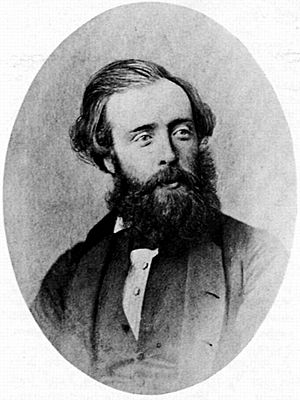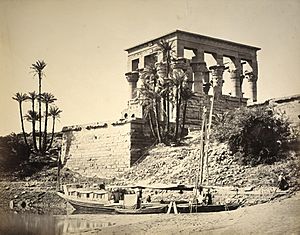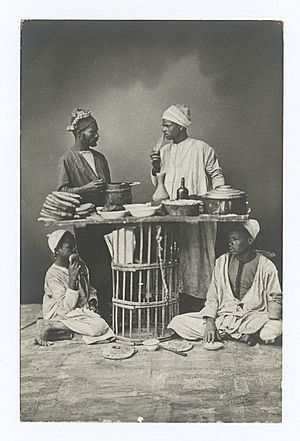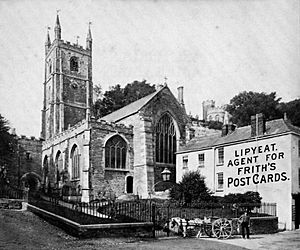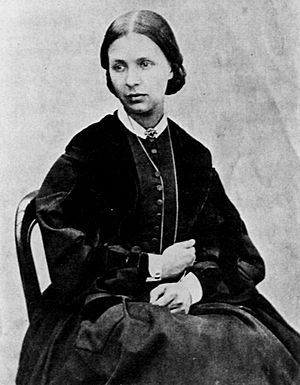Francis Frith facts for kids
Quick facts for kids
Francis Frith
|
|
|---|---|
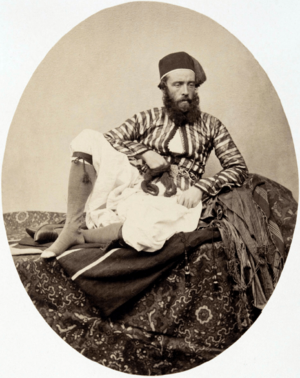
Self-portrait in Middle Eastern costume, c. 1857
|
|
| Born | 7 October 1822 Chesterfield, Derbyshire, England
|
| Died | 25 February 1898 (aged 75) Cannes, France
|
| Nationality | English |
| Known for | Photographer and publisher |
| Movement | Orientalist |
Francis Frith (born October 7, 1822 – died February 25, 1898) was an English photographer. He became famous for taking pictures of the Middle East and many towns across the United Kingdom.
Frith was born in Chesterfield, Derbyshire. He went to Quaker schools before starting a business selling cutlery. After a period of illness, he opened a photography studio in Liverpool in 1850. He was also a successful grocer and printer. Frith loved photography and helped start the Liverpool Photographic Society in 1853. In 1855, he sold his other businesses to focus completely on photography. He traveled to the Middle East three times, starting with a trip to Egypt in 1856. He used very large cameras and a special method called the collodion process, which was hard to do in hot, dusty places.
Contents
Early Life and Photography Beginnings
Francis Frith Jr. was the second child and only son of Francis Frith Sr. He grew up in a Quaker family of merchants in Chesterfield, Derbyshire. He first trained in the cutlery business. Later, he became a grocer, supplying ships in Liverpool. He started learning photography around the 1850s. In 1859, he was one of the people who helped create the Liverpool Photographic Society.
Adventures with a Camera (1856–1859)

Frith was one of the first photographers to sell many scenic pictures. He noticed that tourists bought photos of Italy. But people at home, who couldn't travel, bought pictures from other parts of the world. They wanted a true record, "far beyond anything that is in the power of the most accomplished artist." This shows how ambitious Frith was when he went on his first trip to the Nile Valley in 1856. His clever friend, Francis H. Wenham, helped him with lighting.
Frith made two more trips before 1860, taking photos in Palestine and Syria. He also wrote a journal about his travels. He described the challenges, like working in a "smothering little tent." He also noted how hard it was to get the perfect shot. He said, "foregrounds are especially perverse; distance too near or too far." Despite these problems, he took amazing pictures, like "Approach to Philae."
When he was not traveling, he printed his photos in England. He made beautiful illustrated books, such as Egypt and Palestine (1858-60) and Egypt, Palestine and Sinai (1860). These books became very popular.
Francis Frith & Co. and Family Life
After his travels in the Middle East ended in 1859, Frith started his own company. It was called Francis Frith & Co. in Reigate, Surrey. This company became the world's first special publisher of photographs. In 1860, he married Mary Ann Rosling. She was the sister of Alfred Rosling, who was important in the Photographic Society.
Frith then began a huge project: to photograph every town and village in the United Kingdom. He especially wanted to capture important historical or interesting places. At first, he took all the pictures himself. But as his business grew, he hired others to help him. He also started his postcard company. This company became one of the biggest photography studios in the world. Soon, over two thousand shops across the UK were selling his postcards. Many photos from Francis Frith & Co Ltd are now kept in important art collections.
His Published Works
Many of Frith's photographs were put into books. At first, other companies published these books. But by the 1860s, Frith realized he could make more money by publishing his own images. So, he created his own publishing company, F. Frith & Co.
Here are some of his well-known publications:
- Egypt and Palestine, Photographed and Described by Francis Frith, 1858-1859
- Cairo, Sinai, Jerusalem, and the Pyramids of Egypt, 1860
- Egypt, Palestine and Nubia, 1862
- The Gossiping Photographer and Hastings, 1864
His Quaker Beliefs
Frith was a "recorded" minister in the Quaker faith in 1872. At that time, there were only about 250 such ministers in England and Wales. He worked on many committees and often spoke out for pacifism (peace) and abstinence (avoiding alcohol). He also wrote articles and poems for the Quaker journal, the Friends' Quarterly Examiner.
In his sixties, Frith held very modern views for his time. In 1884, he helped publish a pamphlet called A Reasonable Faith. This paper questioned some traditional religious ideas. Even though some Quakers strongly disagreed, Frith's ideas helped lead to more open-minded thinking within the Quaker movement. This paved the way for the good work in charity and education that Quakers are known for today.
Personal Life
Francis Frith married Mary Ann Rosling. They had five children together: Mary Alice, Eustace, Francis Edgar, Mabel, and Cyril.
Death
Francis Frith passed away at his home in Cannes, France, on February 25, 1898. He was 75 years old.
The Francis Frith Collection Continues
Frith's family kept his company going after he died. The business finally closed in 1971. A historian named Bill Jay realized that the company's huge collection of photos was very important for the country. He helped arrange for a company to buy the archive to keep it safe.
In 1975, the collection was relaunched as "The Francis Frith Collection." The goal was to make Frith's amazing photographs available to many people.
In 1977, John Buck bought the archive and has run it as an independent business ever since. In 2016, the company finished scanning all the photos. Now, they have over 330,000 high-quality digital images. These pictures show about 7,000 different cities, towns, and villages. You can explore all these photos on the company's website.
Britain's First Photo Album
A ten-part TV show called Britain's First Photo Album was shown on BBC2 in March 2012. It was presented by John Sergeant. The show explored the history of Francis Frith's amazing photography work.
A book with the same title, Britain's First Photo Album, was also published. It has 320 pages.
See also
- List of Orientalist artists
- Orientalism
- Photochrom


